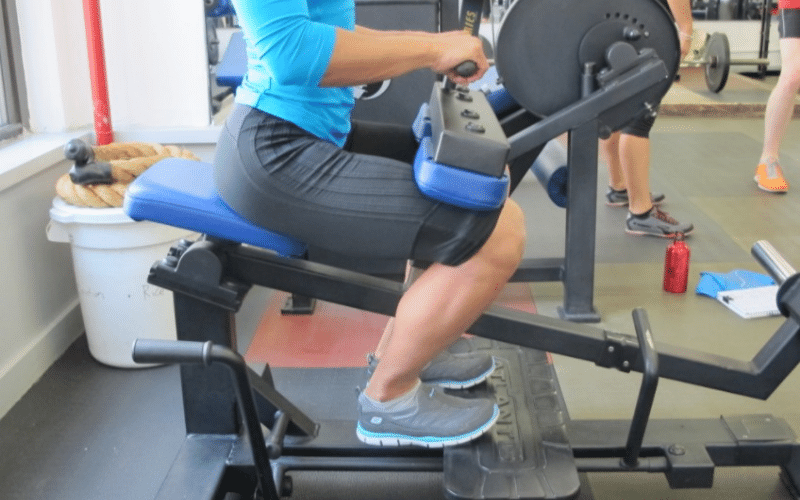Table of Contents

I always thought that the seated calf raise was a complete waste of time. Until I started doing them! You can do your reps faster and with more weight than standing,
really isolating the soleus (calf muscle), and it’s almost impossible to cheat. The results are proof: Add an inch to your calves in 1 month by doing these. It takes dedication, but it works.
Seated Calf Raise Benefit
Targeted Soleus Muscle: Seated calf raises work the soleus muscle more than any other type of leg training (standing or seated).
That is, if you do them correctly and don’t cheat. The core support muscles in the lower back and abdomen must contract constantly to keep you from swaying and swinging during each rep.
If they become fatigued, the weight will cause your body to sway forward on each lift. You will be forced to use assistance from your hips, hamstrings and glutes, which will take away from the intended target of calf development.
How to do Seated Calf Raises
To begin, sit at a calf machine with the balls of your feet under the foot pad and your heels extending off of it. Position yourself so that you are stable and can hold yourself in place from swaying from side to side.
Make sure the pads are situated so they press firmly on top of your feet above your toes. Begin by pushing against the balls of your feet to raise the weight upward until almost straightened out.
Do not lock out or bounce during any part of this action. Keep constant tension on the calves throughout each rep.
Slowly lower the weight back to slightly below straight position while controlling it for 3 seconds (count 1-one thousand). Repeat until desired reps are performed. finished; stand up slowly!
How Many Reps and Sets?
3 sets of 15 reps; if that’s too easy, do 4 sets of 12 reps; if that feels like nothing, do 5 sets of 10 reps; eventually working up to 6 sets of 8 reps.
Week 1: 3 sets x 15reps
Week 2: 4sets x 12reps
Week 3: 5sets x 10reps
Week 4: 6sets x 8reps
On your final set, go to failure – meaning you can’t do another rep with good form. When you fail, rack the weight and rest for 30 seconds.
If you still have some gas in the tank after reaching failure, perform “Calf Pumps” by simply flexing your calves as hard as possible up to 100 times without releasing the contraction.
This should take less than 20-30s total.
Seated Calf Raise vs Standing
Standing Calf Raises are the most common, but Seated Calf Raises work the soleus muscle much better.
Seated calf raises isolate the soleus very effectively because there is no action at the hip or knee joints to take away from the intended muscle.
The calves have two main muscles: gastrocnemius and soleus. Gastroc, the larger one, is mostly used for leaping, running and jumping.
Soleus, which lies underneath it- is a semi supporting/stabilizing muscle mainly involved in standing posture and exercise where only slight movement occurs at the ankle joint.
Seated Calf Raise at Home without a Machine
You don’t need a machine for this – try placing your feet on the bottom rung of a step, or prop your feet up on an ottoman (couch cushion).
If you’re at home and don’t have access to any weights at all, sit down in a chair and push against the edge of the seat with your toes.
This is insanely effective. It works great for people who travel frequently because they can always find something to push against when they get to their hotel room.
Seated Calf Raise with Dumbbell
You can do this with a dumbbell, too. Just sit on the edge of a bench or chair and place a plate on your foot (make sure there’s no gap between the plate and ball of your foot).
Grab onto something for balance and lift.
Caution: If you perform many reps with this variation, you’re going to get huge!
Seated Calf Raise Variation
One Arm Seated Calf Raise: This is one of my favorite exercises to fry calf muscles fast. Do it like so: Sit down on an elevated bench, grab onto some support at your sides and pick up one heavy dumbbell in front of you with your feet evenly spaced apartball of each foot pressed firmly on top of a plate.
Keeping your back and core engaged so you don’t tip backward, raise the weight upward until almost straightened out.
Don’t lock out or bounce during any part of this action! Keep constant tension on the calves throughout each rep. Perform all reps for one side before switching.
My Thoughts:
Seated Calf Raises are now my favorite calf exercise by far; they seem to work much better than standing raises. Next time you train calves, try them and see for yourself! You won’t be disappointed.
[wp-stealth-ads rows=”2″ mobile-rows=”2″]

